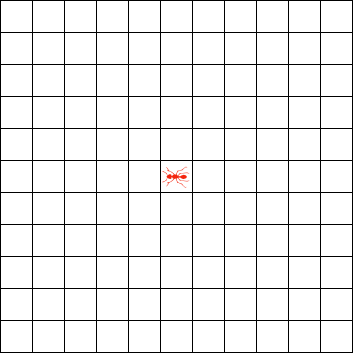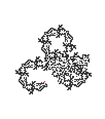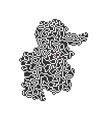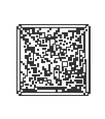Langton's ant is a two-dimensional Turing machine with a very simple set of rules but complicated emergent behavior. It was invented by Chris Langton in 1986 and runs on a square lattice of black and white cells.[1] The universality of Langton's ant was proven in 2000.[2] The idea has been generalized in several different ways, such as turmites which add more colors and more states.
Contents |
Rules
Squares on a plane are colored variously either black or white. We arbitrarily identify one square as the "ant". The ant can travel in any of the four cardinal directions at each step it takes. The ant moves according to the rules below:
- At a white square, turn 90° right, flip the color of the square, move forward one unit
- At a black square, turn 90° left, flip the color of the square, move forward one unit
These simple rules lead to surprisingly complex behavior: after an initial period of apparently chaotic behavior, that lasts for about 10,000 steps (in the simplest case), the ant starts building a recurrent "highway" pattern of 104 steps that repeat indefinitely. All finite initial configurations tested eventually converge to the same repetitive pattern suggesting that the "highway" is an attractor of Langton's ant, but no one has been able to prove that this is true for all such initial configurations. It is only known that the ant's trajectory is always unbounded regardless of the initial configuration[3] - this is known as the Cohen-Kung theorem.[4]
Langton's ant can also be described as a cellular automaton, where most of the grid is colored black or white, and the "ant" square has one of eight different colors assigned to encode the combination of black/white state and the current direction of motion of the ant.
Universality
In 2000, Gajardo et al. showed a construction that calculates any boolean circuit using the trajectory of a single instance of Langton's ant.[2] Thus, it would be possible to simulate a Turing machine using the ant's trajectory for computation. This means that the ant is capable of universal computation.
Extension to multiple colors
Greg Turk and Jim Propp considered a simple extension to Langton's ant where instead of just two colors, more colors are used.[5] The colors are modified in a cyclic fashion. A simple naming scheme is used: for each of the successive colors, a letter 'L' or 'R' is used to indicate whether a left or right turn should be taken. Langton's ant has the name 'RL' in this naming scheme.
Some of these extended Langton's ants produce patterns that become symmetric over and over again. One of the simplest examples is the ant 'RLLR'. One sufficient condition for this to happen is that the ant's name, seen as a cyclic list, consists of consecutive pairs of identical letters 'LL' or 'RR' (the term "cyclic list" indicates that the last letter may pair with the first one.) The proof involves Truchet tiles.
Extension to multiple states
A further extension of Langton's Ants is to consider multiple states of the Turing machine - as if the ant itself has a color that can change. These ants are called turmites, a contraction of "Turing machine termites". Common behaviours include the production of highways, chaotic growth and spiral growth.[6]
| Constructing a Fibonacci spiral. |
Extension to multiple ants
Multiple Langton's ants can co-exist on the 2D plane, as long as there is a rule for what happens when they meet. Ed Pegg, Jr. considered turmites that can turn for example both left and right, splitting in two and annihilating each other when they meet.[7]
See also
References
- ^ Langton, Chris G. (1986). "Studying artificial life with cellular automata". Physica D: Nonlinear Phenomena 22 (1-3): 120–149. doi:10.1016/0167-2789(86)90237-X. http://hdl.handle.net/2027.42/26022.
- ^ a b Gajardo, A.; A. Moreira, E. Goles (15 March 2002). "Complexity of Langton's ant". Discrete Applied Mathematics 117: 41–50. doi:10.1016/S0166-218X(00)00334-6. http://www.dim.uchile.cl/~anmoreir/oficial/langton_dam.pdf.
- ^ Bunimovich, Leonid A.; Serge E. Troubetzkoy (1992). "Recurrence properties of Lorentz lattice gas cellular automata". Journal of Statistical Physics 67: 289–302. doi:10.1007/BF01049035.
- ^ Weisstein, Eric W., "Cohen-Kung Theorem" from MathWorld.
- ^ Gale, D.; J. Propp, S. Sutherland, S.Troubetzkoy (1995). "Further Travels with My Ant". Mathematical Entertainments column, Mathematical Intelligencer 17: 48–56. http://www.math.sunysb.edu/cgi-bin/preprint.pl?ims95-1.
- ^ Pegg, Jr., Ed. Turmite. From MathWorld--A Wolfram Web Resource, created by Eric W. Weisstein. http://mathworld.wolfram.com/Turmite.html. Retrieved 15 October 2009.
- ^ Pegg, Jr., Ed. "Math Puzzle". http://www.mathpuzzle.com/26Mar03.html. Retrieved 15 October 2009.
External links
|
- Weisstein, Eric W., "Langton's Ant" from MathWorld.
- Online demonstration of Langton's ant
- Generalized Ants
- Java applet with multiple colours and programmable ants
- Langton's ant in 3-D (examples and small demo program)
- Mathematical Recreations column by Ian Stewart using Langton's Ant as a metaphor for a Theory of everything. Contains the proof that Langton's ant is unbounded.
- Java applet on several grids and editable graphs, it shows how the ant can compute logical gates
- Programming Langton's ants in Python using Pygame.
- A video demo of different multiple-color Langton's Ants
- Golly script for generating rules in the multiple color extension of Langton's ant












4 comments:
Hi Steven,
Interesting and yet my first observation would be that the ant always starts in the middle and the potential of the space finite. This contrasts with the algorithm that reveals mathematical entities such as the Mandelbrot set, where there is no centre to form a beginning with the first iteration not placing a limit so much outward yet rather providing a space that is afterwards defined infinitely inwards and down as far as we are able to perceive. None the less the entire form of the set is predetermined by the algorithm with that never able to be changed, with only having the consequences of infinity leaving us as uncertain as exactly what it looks like beyond what we can explore. That’s to say it is this type of space and its evolution I think should be given greater consideration in the attempted understanding and modeling of what is deemed as being physical reality.
Best,
Phil
Hi Phil,
Thanks for replying. You wrote:
Interesting and yet my first observation would be that the ant always starts in the middle and the potential of the space finite.
If seen in a certain light, I believe you might have advanced science with that statement, Phil. But only if we get the word out.
The certain light is: "particles", whatever the hell those are. While not "exactly" occupying a finite space, if they are as Quantum Field Theory implies no more than "bundled up waves", they nevertheless seem to occupy a "space" that gives the illusion of a finite space, the fuzzy border of which is where their influence drastically drops off.
(As a fringe benefit this also can be tied into your "Theory of Blends" to a certain extent, methinks.)
Very nicely done, Philip.
See also
http://code.google.com/p/ruletablerepository/wiki/TwoDimensionalTuringMachines
Langtons ant and game of life now have a 1st order recurrence relation so can be iterated on a simple 4 function calculator.
Post a Comment